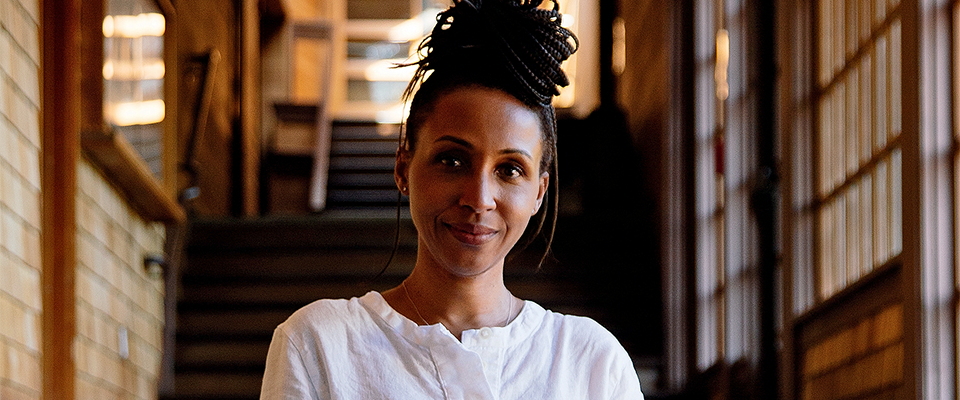The forecast for newspapers may be grim, but J-schools look to a brighter future.
As each week brings new reports of layoffs, buyouts, and bankruptcies across the print spectrum, the only thing clear is that an era in American journalism is ending. Graduate journalism programs, charged with training the next generation of professionals for a vocation no longer sustained by a solvent business model, are in the midst of re-inventing themselves, led by the elite programs at Berkeley, Columbia, and Northwestern. The challenge is that no one knows what comes next.
“We do ask ourselves what the hell are we doing here—are we teaching people to tune up Model A’s or horse-drawn buggies?” says Cynthia Gorney, a longtime professor at Berkeley’s Graduate School of Journalism. Gorney is a former Washington Post reporter whose 2000 book Articles of Faith: A Frontline History of the Abortion Wars is the definitive account of the struggle over abortion in the United States. She specializes in teaching long-form magazine-style writing—the kind of craft that is the antithesis of Twittering and other Web-driven information forms.
J-schools are responding to the rise of digital media by integrating new skills into their curricula, while continuing to emphasize the essential value of information gathering and storytelling. But the tectonic economic shifts responsible for toppling journalism’s 20th century economic model can’t be navigated with a course on building websites. As advertising dollars rush away from print outlets, the disruption is upending a hoary journalistic hierarchy built on daily newspapers. In that tradition, journalists kept separate, if not aloof, not only from advertisers but from all the business of a media company. Now, for the first time in more than a century, aspiring journalists looking for work may well end up starting a new business from the ground up—requiring skills that J-schools have mostly shunned, such as financial planning, accounting, and entrepreneurism.
There is little consensus among J-schools about precisely how to prepare students. “There’s a lot of discussion about how we’re going to support quality journalism, and there’s really few clues about the answer,” says Steven S. Duke, who runs the Media Management Center of Northwestern University’s Medill School of Journalism. It’s clear that something has to change, because “for as long as I’ve been in journalism, journalists have mostly operated with willful ignorance about where our paychecks come from,” he says, although “I wouldn’t be working here if I had that answer; I’d be rich.”
To begin finding that answer, J-schools need a firm grip on what exactly has changed with the rise of the Internet. Few media observers have a keener overview of the rapidly shifting media landscape than Alan Mutter, an adjunct professor at the Berkeley program and a veteran newspaper executive with extensive management experience in Silicon Valley startups. His widely cited blog, Reflections of a Newsosaur (Newsosaur Blogspot), has become a key forum in which journalists, newspaper executives, and their critics hash out the causes of journalism’s woes.
Mutter himself points to what he calls journalism’s “original sin”—the decision to give away online content for free. Now, he says, “People are very emotionally opposed to paying for content. I don’t blame them. If I could eat chocolate fudge all day long and not get fat, I would. As print ads diminish, the print business is not cranking out dollars, and no one has found a way to charge for online content.” Instead of attracting more readers so that papers could charge more for the print ads that provided the bulk of their revenue, the boom in cheaply produced online content diluted reader pools everywhere.
Daily newspapers once held a monopolistic position in the community, which allowed them to charge high advertising rates. (Even after the rise of radio and television, newspapers consistently sucked up nearly 70 percent of all ad revenue in urban markets.) As Mutter sees it, the combination of falling subscription rates, debt-laden newspaper chains, and plummeting ad revenue has been lethal for print journalism, which would be facing tough times even without the recession.
So where does this leave students trying to plot a career in journalism? At Berkeley, the J-school is trying to teach a new attitude to budding journalists, along with the new skills. Last spring, the school offered its first seminar on freelancing, and the J-200 “boot camp” course required for all incoming students now encompasses the multimedia reality. Mutter’s own course, The Future of Journalism in an Age of Disruptive Change, was designed to help young journalists create their own opportunities rather than follow a set career path. “The take-away skill in this class is how to recognize, evaluate, and respond to change, while staying true to the core values of objective inquiry and compelling storytelling,” Mutter says. “The idea that people want to tell other people what they know, what the government is doing, these are basic human instincts…. The job of the journalist is to figure out where she needs to go to have the resources to do good work.”
Among J-school students, gallows humor has flourished. It’s not that recent grads haven’t found positions. As veteran journalists take buyouts or become layoff casualties, freshly minted graduates make attractive replacements, with their tolerance for long hours and lower starting salaries. But professors estimate that even in the best of times not more than half the school’s alumni are still working in the field five years after graduation. As the situation approaches the worst of times, students face a bleak, recessionary employment market with a mandate to re-invent their profession. It’s the kind of mission that draws people to business school, not journalism.
“Up until now there’s been a lot of joking, being in school for an industry that’s collapsing,” says Emma Brown, M.J. ’09, a standout student who landed a prestigious internship at The Boston Globe in summer 2008, having interned at California the year before. “We hear a lot that young journalists will be the ones who figure it out. We have multimedia skills, and think on multiple platforms. But … people don’t expect to make a lot of money; they’re just hoping to get a job doing what they love.”
A two-year master’s program, Berkeley’s J-school is one of only two graduate programs in the country that focus exclusively on journalism, eschewing courses on communication theory, public relations, and information technology (Columbia is the other). Although Berkeley started offering a journalism master’s in 1952, the University’s professional school was born in the tumultuous year of 1968, and for the first quarter-century was largely overshadowed by Columbia’s program. Over the past decade, Berkeley’s J-school has grown more competitive, and the faculty more prominent, with agenda-setting journalists such as Michael Pollan, Cynthia Gorney, Lowell Bergman, and Mark Danner.
So it’s difficult to overstate the central role that newspapers have played in the pedagogic paradigm at Berkeley. “Traditionally we’ve always seen newspapers as the foundation of everything we want to do,” says Neil Henry, a J-school professor since 1993 and the school’s new dean. “Our entering course, the news reporting class J-200, is geared so that when students finish the first semester they should be able to take on any general assignment gig at any newspaper in the country.”
A compact man bristling with energy, Henry earned a sterling reputation as a reporter at The Washington Post and Newsweek. He’s thought a lot about what the Internet age means for reporting. His 2007 UC Press book American Carnival: Journalism Under Siege in an Age of New Media makes a compelling case for preserving journalistic values that he sees being undermined by cable TV shout fests and editor-less blogs running one-source rumors.
Not that Berkeley lagged when it came to recognizing the digital revolution. The J-school has been teaching electronic reporting skills since the mid-1990s, an initiative championed by Paul Grabowicz, a rumpled, old-school investigative reporter who now directs the school’s New Media Program. In recent years, the J-school has woven multimedia training throughout the curriculum, so it’s impossible to graduate without a working knowledge of some electronic media.
In the 2008–09 school year, the school started to address the reality that students might need an entirely different skill set. For the first time, it offered a course on new media and entrepreneurship co-taught by David Charron, a professor and assistant director of the Lester Center for Innovation and Entrepreneurship at the Haas School of Business.
Columbia has come to similar conclusions. In 2009, for the first time, every student is required to take a course on the economics of journalism, says Nicholas Lemann, dean of the Columbia Graduate School of Journalism. Rather than focusing on the progression of First Amendment case law, the required course on the history of journalism is looking into fair-use precedents, such as those applicable to aggregating sites. Like other elite J-schools, Columbia is geared toward training leaders, but today that means preparing journalists to launch or run a news organization shortly after graduation rather than nab a spot in a top newsroom. “The traditional attitude was … if you’re a professional journalist, it’s not on you to think about the business side, except that you should push back if it’s not sufficiently supportive,” Lemann says. Again, this requires a sea change in attitudes about the role of commerce and journalism, or at least recognition that entrepreneurial savvy is a valuable skill rather than a suspect aptitude. “That means thinking about how the editorial side is being supported. The traditional attitude that’s it wrong to even know anything has clearly outlived it usefulness, and was probably overstated to begin with.”
At Berkeley, students are learning the skills required to create news outlets. For 2008, supported by a large grant from the Ford Foundation, the J-200 course incorporated a new online component featuring interactive projects by the students. Each class published a community-specific website: Mission Loc@l, covering San Francisco’s Mission District; plus Oakland North, El Cerrito Focus, inEmeryville, and East Bay West Online that focus on underserved East Bay communities. More than a multimedia training ground, the program gives students experience applicable to launching their own online journalistic ventures, a path that has shown some promise via nonprofit online news outlets in San Diego, the Twin Cities, Seattle, and St. Louis.
The J-school faces a quandary. It’s never been more prominent, but the newspaper and magazine jobs to which it’s geared are rapidly disappearing. Students still covet the intensive editing and prose coaching from smart and skillful journalists, but they know it’s unlikely they’ll be able to follow in their teachers’ career footsteps.
“I’ve noticed a real change with students over the last year or so,” says J-school Professor Lydia Chavez, who covered the 1980s wars in Central America for the Los Angeles Times. “Students conceive of themselves as entrepreneurs. I never conceived of myself that way. I wanted a paycheck.”





















